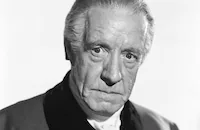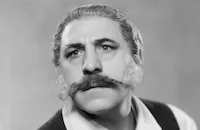Romance

Brief Synopsis
Cast & Crew
Clarence Brown
Greta Garbo
Lewis Stone
Gavin Gordon
Elliott Nugent
Florence Lake
Film Details
Technical Specs

Synopsis
On New Year's Eve, an aging bishop tells his grandson, Harry, of the great love affair of his youth: At an evening party given by Cornelius Van Tuyl, Tom Armstrong, the son of an aristocratic family and the rector of St. Giles, meets the famous Italian opera star Rita Cavallini and falls in love with her, in spite of rumors that she is Van Tuyl's mistress. Tom persists although his family disapproves of Rita, but at length their romance is ended on another New Year's Eve by mutual agreement because of their differing stations in life. The bishop tells how he later married another woman and counsels Harry to marry the woman he loves regardless of the consequences.

Director

Clarence Brown
Cast

Greta Garbo

Lewis Stone

Gavin Gordon

Elliott Nugent
Florence Lake
Clara Blandick

Henry Armetta
Mathilde Comont
Countess De Liguoro
Crew

Videos
Movie Clip




Film Details
Technical Specs

Award Nominations
Best Actress
Best Director
Articles
Romance
Romance (1930), Garbo's second talking film, was the much-anticipated follow-up to the smash success of Anna Christie (1930). While on the whole it was not regarded as one of her best pictures, her own performance was praised by the critics and drew solid box office receipts, proving her durability with the transition to sound. Mordaunt Hall of the New York Times wrote that "Greta Garbo's performance in Romance is perhaps as good as anything she has done on the screen [...]"; Norbert Lusk wrote in Picture Play: "Her performance is a thing of pure beauty, an inspiring blend of intellect and emotion, a tender, poignant, poetic portrait of a woman who thrusts love from her because she considers herself unworthy of the man who offers it." That year she received an Academy Award nomination for Best Actress for her performances in this film and Anna Christie, though she lost to Norma Shearer. The "Empress Eugenie" hat which she wore in the film became a much-imitated fashion accessory.
Gavin Gordon, an established stage actor who was brought to Hollywood in the early sound era, could hardly hope to match the romantic intensity of John Gilbert, Garbo's great leading man of the silent era. To be fair, his performance was surely hampered by the fact that he had fractured his collarbone in a car accident on the way to his first day of shooting and was in severe pain throughout, having to keep his shoulder and arm in a sling until the final take of each shot. Garbo, who had been impressed with his screen tests, insisted on keeping him even though the studio wanted to find a replacement. Gordon later found his true calling as a character actor, appearing in such diverse films as Mystery of the Wax Museum (1933), The Scarlet Empress (1934), The Bride of Frankenstein (1935), Notorious (1946), The Ten Commandments (1956) and The Nutty Professor (1963).
Playwright Edward Sheldon (1886-1946), born into the Chicago elite and trained at the Harvard Dramatic Club, specialized in socially-conscious melodramas such as Salvation Nell (1915). His 1913 play Romance, from which this film is adapted, was one of the greatest successes of its day, running for over 1,000 performances on the London stage. Although a rare crippling disorder left him immobile and later blind during the last few decades of his life, he continued to have a significant impact on the American theater scene, helping younger playwrights such as Thornton Wilder sharpen their craft. Up to the time of his death, his New York apartment continued to have a steady flow of visitors, including Helen Hayes, Sir John Gielgud and Lillian Gish, who referred to him once as "the pope of the theater." Other film adaptations of his work include Salvation Nell (1931), The Song of Songs (1933) and Lulu Belle (1948).
Massachusetts-born director Clarence Brown (1890-1987) studied engineering in Tennessee and later opened his own automobile company in Alabama before moving to Fort Lee, New Jersey in 1915 and becoming an assistant to Maurice Tourneur, one of the leading directors of the era. When Tourneur was injured while directing The Last of the Mohicans (1920), Brown took over and was credited as co-director. By the mid-20s he was working on prestigious projects such as the Rudolph Valentino vehicle The Eagle (1925). One of MGM's most consistent and professionally respected directors, he became Garbo's favorite, working patiently with her on projects such as Flesh and the Devil (1926) and A Woman of Affairs (1928) and her first talkie, Anna Christie (1930). Later films of note by Brown include The Human Comedy (1943), Intruder in the Dust (1949) and the classic family picture The Yearling (1946). He received two Academy Award nominations in the same year for his work on Romance and Anna Christie.
Cinematographer William H. Daniels, like Brown, worked with Garbo extensively both because of his immense professional skill and his ability to work with the demanding actress; in fact, with only a couple of exceptions, he photographed all of her films at MGM. Starting as a camera operator for Erich von Stroheim's Blind Husbands (1919), Daniels co-photographed several other Stroheim films, including Greed (1925). Later in his career he won an Academy Award for his work on Jules Dassin's film noir The Naked City (1948).
Elliott Nugent (1899-1980) first appeared on stage as a child with his family on vaudeville. A remarkably versatile talent, his career was more or less equally divided between acting, writing and directing; his best-known work is The Male Animal (1940), a Broadway hit which he co-wrote with James Thurber and adapted for the screen in 1942. In 1965 he published his autobiography, Events Leading Up to the Comedy. Clara Blandick (1881-1962), born in Hong Kong, made her first films in the 1910s, though until the 1930s she acted mainly on the stage. Since she was already in her 50s by that time, her subsequent film roles tended to be matronly figures such as Aunt Polly in Tom Sawyer (1930), Huckleberry Finn (1931) and Tom Sawyer, Detective (1938). But her most famous role by far is Auntie Em in The Wizard of Oz (1939). In 1962 she committed suicide due to worsening health. Henry Armetta (1888-1945) emigrated from Italy to the U.S. in 1902, stowing away on a boat to New York. He moved to Hollywood in the early 1920s, where he found a steady career as a character actor. He was much in demand for roles requiring broadly gesturing, heavily-accented Italian barbers, waiters, chefs, street vendors, and the like, typically with names such as Tony, Nick or Gambini.
Producer: Clarence Brown
Director: Clarence Brown
Screenwriter: Bess Meredyth, Edwin Justus Mayer, based on the play by Edward Brewster Sheldon
Cinematographer: William Daniels
Editor: Hugh Wynn
Art Director: Cedric Gibbons
Gowns: Adrian
Cast: Great Garbo (Rita Cavallini), Gavin Gordon (Tom Armstrong), Lewis Stone (Cornelius Van Tuyl), Elliott Nugent (Harry), Florence Lake (Susan Van Tuyl), Clara Blandick (Miss Armstrong), Henry Armetta (Beppo), Mathilde Comont (Vannucci), Rina De Liguoro (Nina).
BW-77m. Closed captioning.
by James Steffen

Romance
Quotes
Trivia
The original play opened in New York on 10 February 1913.
Notes
Greta Garbo received an Academy Award nomination for her work on this film and Anna Christie. Director Clarence Brown also received an Academy Award nomination for his work on this film and Anna Christie.

Miscellaneous Notes
Released in United States 1930
Released in United States 1930













